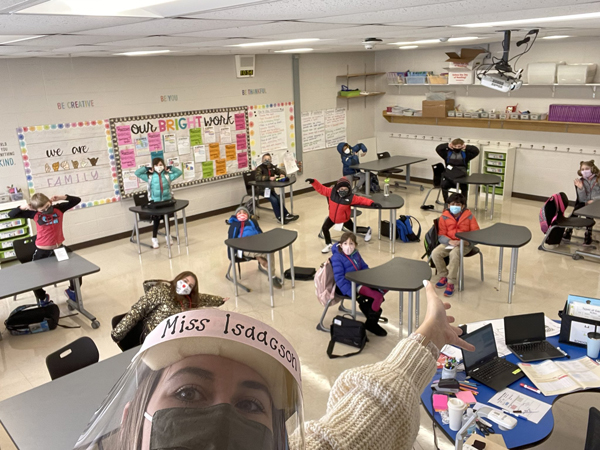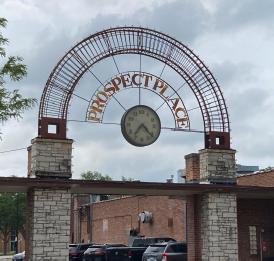By Ben Finfer
District Communications Specialist

As with districts all over the country, the COVID-19 pandemic affected River Trails School District 26 in every way imaginable.
In March 2020, the seriousness of COVID-19 began to set in, which led to a quick change to online learning. This was difficult because it required our students and teachers to learn new technology and processes that had never been utilized before. A lot of collaboration went into planning this phase of the pandemic which would ultimately set the stage for how the District would handle a new learning environment over the next 18+ months.
We began preparing about two weeks prior to the governor’s “stay at home” order. Our instructional coaches developed lessons for what we thought would only be a few weeks at home. Not only were these lessons shared around our District, but many other districts in the area used and modified our work. Our goals were to do the best we could for our students in less-than-ideal circumstances and that meant sharing the workload.
The district already had one-to-one Chromebooks for students. However, in grades PK-3 they were kept in the classroom. In addition, we had students without Internet access at home. We were fortunate to partner with Maine Township School District 207 which provided us with additional hot spots that we distributed to these families.
The pandemic wasn’t just complex for logistical reasons. It also had an emotional impact on everyone. Students were expected to continue learning in isolation and without the typical experiences that all children deserve. Sports and other after-school activities were cancelled or moved to digital formats. Daily interactions with friends, schoolmates and teachers were limited or eliminated altogether.
Teachers had to learn a whole new way to teach. Somehow, they had to hold the attention of their students and be a source of comfort while managing their own families and mental well-being. It was an overwhelming experience and did not allow for the typical support that a teacher might otherwise have.

Online learning was certainly much more of a challenge at the beginning when the processes and hardware had to be sorted out. There was very little time for preparation. There were some additional challenges for our youngest learners. Imagine 20 kindergarteners all trying to talk to you at once! And they think you have been able to hear them. We also met a lot of family members and pets as they joined in on screen. Eventually everyone was much more comfortable with the setup, even if there was always a level of difficulty to it.
There was also an effect on the rest of the District staff. The maintenance department had to prepare buildings for the eventual return of students; administrators had to make completely new calendars and plans for the school year; and others had to figure out how to complete their daily tasks at home without the resources offered in an office environment.
The 2020 school year ended while on lockdown and an 8th grade car parade was our “promotion” ceremony.
The district began the 2020-2021 school year with remote learning. In October 2020, we moved to a hybrid model with some students attending in person for half the day, while others remained in a remote environment. However, after some students and staff tested positive the district quickly pivoted to remote learning again.
This remained in effect until the district returned to hybrid in-person learning in January 2021 and full-time in-person learning in April 2021. However, students were still able to remain in a remote learning environment, if they chose to do so. About 75% of the student population returned to the buildings, in addition to much of the staff. And teachers took advantage of outdoor learning opportunities, whenever possible.
Everyone handled the situation differently, though no one had an easy time of it. Some students were better suited for e-learning than others.
The same applies to teachers. However, it is fair to say that it was an overwhelming experience for most, if not all, of them. It was not the job they had signed up for and things were changing on a week-to-week basis. But the teachers were committed to making it work because they understood the importance of being a stable force in their students’ lives. The fact that the District was able to endure, and even thrive, was because of the teachers’ dedication to their students.
Morning meetings became an essential component for all of our students and staff. It was a way to check in and make sure everyone was okay. It also became a way to let each individual child know they are important and to see if some needed additional interventions.

By the fall of 2021, returning with masks and social distancing did not seem so strange. We had figured out how to provide students with high quality learning and fun in a safe environment.
Most teachers were afraid until they walked into school and saw their students. They followed the health protocols and helped improve our systems in order to stay safe. That being said, there are still fears, especially for those that live with others who are immunocompromised.
It was also incredibly difficult to set up classrooms for the needed space between children. Our district had to use every bit of space for classrooms prior to the pandemic and having to maintain proper social distancing made it much more of a challenge. Prairie Trails School, a renovated early learning center, was already under construction as the result of overcrowding at our elementary schools. It is a credit to Dan Whisler, the district’s director of buildings and grounds, along with his team, that we were able to get the classrooms set up for safe learning.
It also forced us to get creative with how we used various spaces. Cafeterias and libraries were turned into classrooms, gyms became cafeterias, and even hallways were used as learning spaces from time to time.
There was also more consideration and upgrades to the ventilation system and other measures that were taken to ensure safe classrooms.
One of the silver linings of the pandemic is a better understanding of how to utilize online learning. We, of course, prefer to be in an in-person classroom setting and feel that best suits our students and teachers. However, it is nice to have online learning as an option when there are closures. Everyone is much more comfortable with it now than they were in February 2020.

In some areas students did lose ground. This was mostly in math and reading. There was also the lost social interaction, which could have had an impact.
However, in other areas these students learned more than any other group of students has before. They learned about using technology, personal responsibility and how to adjust on a moment’s notice. They learned compassion and empathy. They were forced to pay more attention to the news, both locally and around the world. In many ways, these children grew up even faster than children usually do.
There were a few children who did not log on to school regularly and we partnered with parents to find ways to encourage participation. In addition, we found that some of our older students did not want to have their cameras on. Sometimes this was due to them learning ‘right out of bed’ in the morning and not looking their best and others did not want their fellow students to see their homes.
When we look back on this time, I think we will think of the pandemic as an incredibly challenging and demanding period. It took a physical and emotional toll on everyone and tested people in countless ways. It was unfair.
At the same time, it brought out the best in many people. It forced teachers and students to learn new skills. It brought the community closer together because that was the only way to best serve the children while keeping people healthy and safe.
It brought out creativity and compassion. We had amazing online talent shows, art exhibits and even celebrated spirit days online. We learned that you can see a smile — even with a mask on. We learned educators matter even more than we realized and that we are all truly better when we work collaboratively.
Our District served hundreds of thousands of meals during this time, feeding our families and bringing much needed resources to share with our community. We partnered with charitable organizations and made sure that our families were fed, clothed and had places to live. We are indebted to every one of these organizations for keeping our community safe.
We will characterize this time as an unimaginable burden and somehow impossible to believe it happened, even though we all experienced it. But in many ways, it was the proudest moment for our school district.

